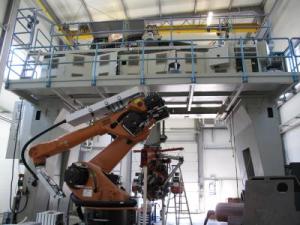May 7 2010
A new hall with a semi-industrial laser system has been built at the GKSS Research Centre, Geesthacht, in collaboration with Airbus Deutschland GmbH. GKSS put in an investment of around a million Euros and the hall was officially opened on 19th April by representatives of GKSS and Airbus. The new system will be used to research laser beam welding of new lightweight construction alloys, among other areas. The material researchers from Geesthacht are taking over the system from the Airbus location in Nordenham.
The new system will be used to optimise welding technologies for innovative lightweight alloys in joint research and development projects. With the pilot welding system, it is now possible to weld up to a length of about nine metres in the newly constructed hall.
 The laser welding hall is equipped with a semi-industrial laser system.
The laser welding hall is equipped with a semi-industrial laser system.
"The system is ideal for our research in the area of strength and reliability of laser welded light-weight structures," explains the Head of Material Mechanics at GKSS, Prof. Norbert Huber.
While investigation at Airbus in Nordenham focused on laser beam welding of length-stiffened profiles, known as stringers, for the external skin of the aluminium fuselage structure of aircrafts, in Geesthacht the focus of investigation is welding of sample models and test components for aircraft fuselage shells.
Knowledge comes in useful
One of the challenges in modern aircraft and vehicle manufacture is to save costs and weight. To produce the fuselage of an aircraft, for example, laser beam welding is increasingly used as a substitute for the traditional technology of riveting.
This particularly saves weight and with it carbon dioxide emissions, while reducing production time. In aircraft manufacture, strict safety regulations must also be observed. Computer simulations and complicated tests are required, which include the welded seams.
Among other techniques, the materials researchers at Geesthacht use the established GKSS characterisation method with neutron and synchrotron radiation for this purpose.
GKSS-ACE Centre
In future, the GKSS Research Centre will increasingly be geared towards development of new lightweight materials and material systems. To this end, construction of the pioneering GKSS "Light-weight Materials Assessment, Computing and Engineering Centre" (ACE) is planned. The new laser system will be part of this expansion.
The particular strength of the ACE research platform will lie in the combination of processing, characterisation and simulation methods. This includes both joining technology and production of sample multi-material systems and complex lightweight structures.
As a further area of research, for example, models will be developed to enable prediction of failure behaviour of such structures under loads similar to real operation.